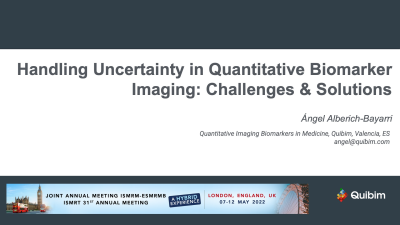Weekend Course
MRI Diagnostics in the Body: Screening Tool & Quantitative Adoption
Joint Annual Meeting ISMRM-ESMRMB & ISMRT 31st Annual Meeting • 07-12 May 2022 • London, UK

| MRI for Screening: Technical Considerations | |||
| 07:45 | Noncontrast Screening Using Diffusion-weighted MRI for Breast Cancer Video Permission Withheld
Hee Shin
As there are growing interests in risk-based supplemental breast cancer screening and concerns about gadolinium deposition in the brain, diffusion-weighted MR imaging (DW MRI) has emerged as a promising modality for identifying mammographically occult malignancy. Current evidence suggests that DW MRI combined with nonenhanced T1- and T2-weighted sequences provides a higher sensitivity than mammography or mammography combined with ultrasound but lower sensitivity than DCE MRI. Advances in DW MRI acquisition, post-processing, and standardized interpretation have significantly improved DW MRI performance in cancer detection. In this lecture, the potential role of DW MRI as a screening modality will be provided.
|
||
| 08:10 | Abbreviated MRI
Christiane Kuhl
|
||
| MRI for Screening: How to Plan Screening Programs | |||
| 08:35 | How to Plan Conduct Screening Program
Elizabeth Morris
|
||
| 09:00 | Integration of AI & MRI in Screening/Risk Prediction
Almir Bitencourt
The use of artificial intelligence (AI) in radiology is rapidly evolving, with many possible applications for different imaging modalities. Breast cancer screening is perhaps the best known and most researched use case. Despite mammography is probably the imaging modality with more data available for breast cancer screening, radiomics and AI have been applied to improve the assessment of breast magnetic resonance imaging (MRI) in different applications, including breast cancer risk prediction, lesion detection and classification. The aim of this presentation is to review the current knowledge and future applications of AI on MRI for breast cancer screening and risk prediction.
|
||
| 09:25 | Break & Meet the Teachers |
||
| Quantitative Imaging Biomarkers in Body MRI I | |||
| 09:50 |  |
Handling Uncertainty in Quantitative Biomarker Imaging: Challenges & Solutions
Angel Alberich-Bayarri
Uncertainty in the quantification of imaging biomarkers from MRI can be minimized by the control of different aspects of the quantification process, based on the principles of metrology science. Both technical and clinical validation are fundamental for the success of the biomarker. Technical validation includes the determination of the accuracy and precision of the measurement. Nevertheless, a biomarker can be not properly adopted in clinical routine if it is not clinically validated. For that, the inclusion of clinical endpoints such as the ones handled in oncology (overall survival, event free survival) is fundamental to demonstrate utility of quantitative imaging. |
|
| 10:15 | Strategies for Assessing Technical Performance of Single & Multiplexed QIBs Video Unavailable |
||
| Quantitative Imaging Biomarkers in Body MRI II | |||
| 10:40 | Exploiting Quantitative Fat Imaging in the Body
Takeshi Yokoo
|
||
| 11:05 | Radiomics: Addressing the Quantitative Challenges
Laure Fournier, Antoine Decoux, Paul Habert, Armelle Arnoux, Loic Duron
|
||
The International Society for Magnetic Resonance in Medicine is accredited by the Accreditation Council for Continuing Medical Education to provide continuing medical education for physicians.